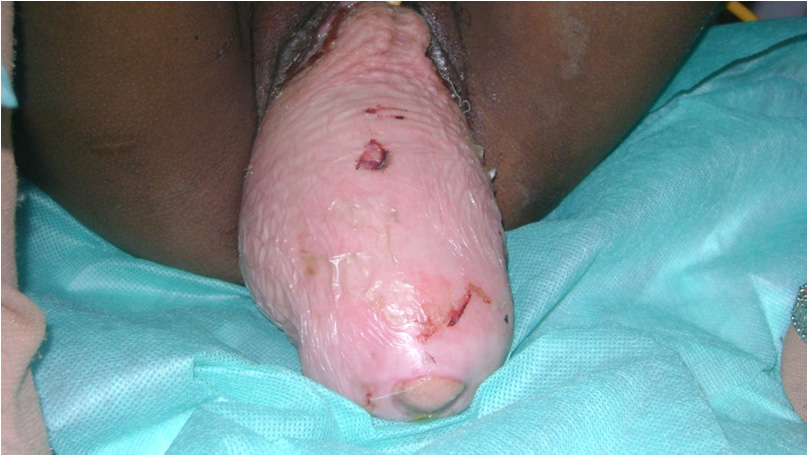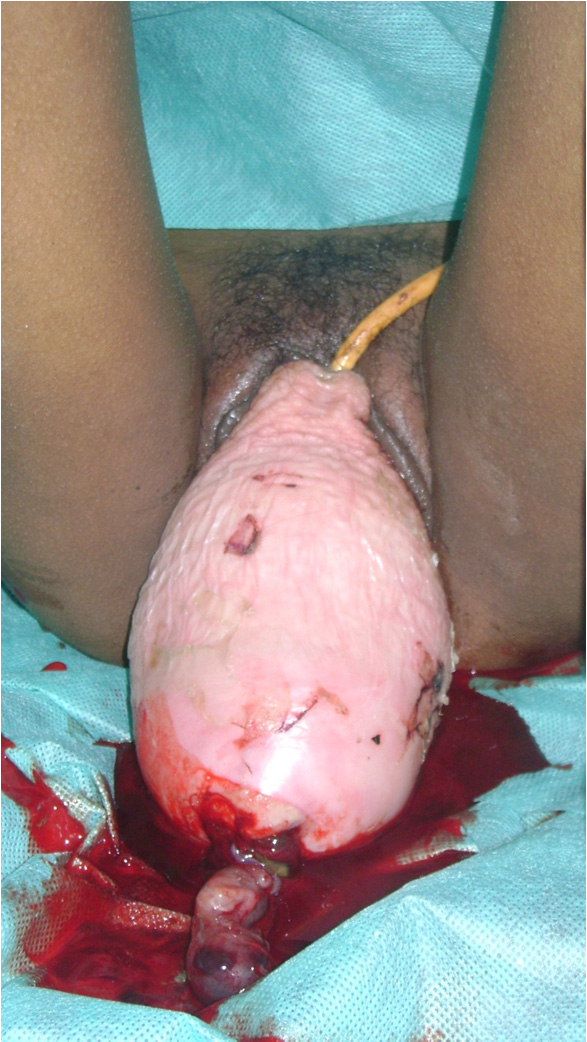Pregnancy with Irreducible Utero-Vaginal Prolapse
Pradip Kumar Saha1, Vanita Suri2, Puja Sikka3
1 Assistant Professor, Department of Obstetrics and Gynecology, Postgraduate Institute of Medical Education & Research (PGIMER), Chandigarh, India.
2 Professor, Department of Obstetrics and Gynecology, Postgraduate Institute of Medical Education & Research (PGIMER), Chandigarh, India.
3 Assistant Professor, Department of Obstetrics and Gynecology, Postgraduate Institute of Medical Education & Research (PGIMER), Chandigarh, India.
NAME, ADDRESS, E-MAIL ID OF THE CORRESPONDING AUTHOR: Dr. Pradip Kumar Saha, Assistant Professor, Department of Obstetrics and Gynecology, Postgraduate Institute of Medical Education & Research (PGIMER), Chandigarh-160012, India.
E-mail: pradiplekha@yahoo.co.in
Pregnancy with uterine prolapse is a relatively rare condition. Irreducible prolapse occurring during pregnancy is even rarer. There is still a need for obstetricians to be aware about the management of uterine prolapse which allows for an uneventful pregnancy, labour and delivery. Here we present a case of a woman who developed irreducible uterine prolapse during pregnancy and the issues surrounding its management. We had to abort her pregnancy to reduce her prolapse which could otherwise have been life threatening.
Gravid uterus, uterine cervix, Uterine prolapse
Case Report
A 28 years old G4P1111 at 15+4 weeks pregnancy was referred to emergency ward in the department of Obstetrics and Gynaecology, Postgraduate Institute of Medical Education and Research, Chandigarh as a case of prolapse uterus with complaint of pain abdomen and difficult to pass urine. She had history of pain abdomen for last 4 days and not able to pass urine completely for same duration. There was no history of chronic cough or constipation.
In her past history she had normal vaginal delivery 10 years back and breech vaginal delivery 7 years back at 28 weeks gestation followed by manual removal of placenta. She also had spontaneous first trimester abortion one year back. She noticed this prolapse for last 7 years. She used to reduce it manually till 4 days back. However, it became irreducible and unable to pass urine completely since last three days.
On examination her vitals were stable. She had mild pallor. Her height was 5 feet 2 inches and weight 38 kg making her BMI 15.8. Her chest and cardiovascular examination did not reveal any abnormality. Her abdomen was soft and non-tender and uterus could not be felt. On local examination there was extensive, oedematous and irreducible uterine prolapse. Whole gravid uterus was lying outside [Table/Fig-1]. There was small decubitus ulcer seen on cervix. Her haemoglobin was 8.5 gm%, and ultrasound examination of the prolapsed uterus showed live fetus of 16 weeks period of gestation.

Catheterization was done. Foot end was elevated and Magnesium dressing was done to reduce oedema and analgesia to reduce her pain. As patient was having excruciating pain reposition was tried under IV sedation but failed. Subsequently she was planned for reposition of her prolapsed uterus under general anaesthesia. However, patient and her husband were counselled and were willing for termination of pregnancy for safe reposition of uterus.
Pregnancy was aborted [Table/Fig-2] by medical methods by using mifepristone and misoprostol. Reposition of prolapsed uterus was done 24 hours after abortion. Ring pessary was applied after three days. Patient was discharged on 4th post abortal day with satisfactory condition. Patient followed up to six weeks and was fine.
Prolapsed uterus with abortus

Discussion
Prolapse of the uterine cervix during pregnancy is an uncommon condition that has been reported rarely in recent literature. The incidence of cervical prolapse in pregnancy has been estimated to be 1 case per 10,000 to 15,000 deliveries [1,2].
Complications of pregnancy with prolapse mentioned in the literature are abortion, retention of urine, Premature rupture of membrane, chorioamnionitis, cervical dystocia, prolonged labour, obstructed labour, operative interference, sub-involution and uterine sepsis [3–5].
The management of gravid uterine prolapse in pregnancy should be individualized depending on the degree of prolapse, period of gestation, associated complication and patient’s desire. Pre-existing uterovaginal prolapse most of the time resolves spontaneously during pregnancy. However, it can persist or recur after delivery [4,6,7]. The management options reported in the literature are conservative management in the form of bed rest in Trandelenburg position and use of vaginal pessary [7–9].
In case of oedema and congestion anti oedema measures like local application of glycerine and acriflavine is also helpful [3,6]. In this case magnesium dressing was applied to reduce the congestion and oedema expecting it would help in reposition however it failed.
Pregnancy with irreducible prolapse is rarely reported in the literature. To the best of our knowledge gravid uterus completely prolapsed outside vagina has never been reported in the literature. Management option considered initially in this case was reposition followed by vaginal pessary and continuation of pregnancy. We tried to reposit it back under sedation after applying antioedema regimen but failed. We did not try under general anaesthesia. Eventually pregnancy was terminated for reposition of uterus.
Conclusion
Obstetricians should be aware of this rare condition of irreducible prolapse of gravid uterus and in rare condition pregnancy may have to be aborted for safe reposition of prolapsed gravid uterus.
[1]. Keettel WC, Prolapse of the uterus during pregnancyAm J Obstet Gynecol 1941 42:121-26. [Google Scholar]
[2]. Brown HL, Cervical prolapse complicating pregnancyJ Natl Med Assoc 1997 89:346-48. [Google Scholar]
[3]. Ghose S, Samal S, Coumary S, Pallavee P, Jenkins A, Utero-vaginal prolapse in primigravida: a case reportInt J Reprod Contracept Obstet Gynecol 2012 1:50-51. [Google Scholar]
[4]. Gupta R, Tickoo G, Persistent uterine prolapse during pregnancy and labourJ Obstet Gynaecol India 2012 62:568-70. [Google Scholar]
[5]. Usharani N, Raghuveer C, Cervical prolapse during third trimester: A Rare EntityJournal of Evidence based Medicine and Healthcare 2014 1(13):1646-48. [Google Scholar]
[6]. Horowitz ER, Yogev Y, Hod M, Kaplan B, Prolapse and elongation of the cervix during pregnancyInt J Gynaecol Obstet 2002 77:147-48. [Google Scholar]
[7]. Hill PS, Uterine prolapse complicating pregnancy. A case reportJ Reprod Med 1984 29:631-33. [Google Scholar]
[8]. Guariglia L, Carducci B, Botta A, Ferrazzani S, Caruso A, Uterine prolapse in pregnancyGynecol Obstet Invest 2005 60:192-94. [Google Scholar]
[9]. Partsinevelos GA, Mesogitis S, Papantoniou N, Antsaklis A, Uterine prolapse in pregnancy: a rare condition an obstetrician should be familiar withFetal Diagn Ther 2008 24:296-98. [Google Scholar]